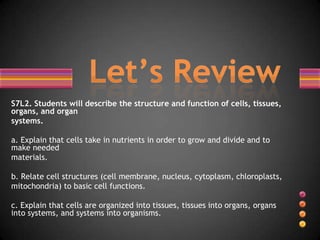Cell review
- 1. S7L2. Students will describe the structure and function of cells, tissues, organs, and organ systems. a. Explain that cells take in nutrients in order to grow and divide and to make needed materials. b. Relate cell structures (cell membrane, nucleus, cytoplasm, chloroplasts, mitochondria) to basic cell functions. c. Explain that cells are organized into tissues, tissues into organs, organs into systems, and systems into organisms.
- 2. EQ: How can I summarize what I have learned about cells?
- 4. All cells have a cell membrane and contain cytoplasm. Eukaryotic, prokaryotic, plant, and animal cells ALL contain cytoplasm surrounded by a cell membrane (pg. 38).
- 5. Prokaryotic cells have many membrane bound structures. Eukaryotic cells have membrane bound structures. Prokaryotic cells do not (pg.39).
- 6. What is the structure that surrounds all cells, letting some substances in and out? The Cell Membrane allows very small molecules, such as oxygen molecules, to pass through it (pg. 38).
- 7. The jelly-like substance in a cell that holds all organelles in place is called:
- 8. Tough outer structure that gives some cells their box-like shape: Cytoplasm Chloroplasts Cell Armor Cell Membrane Cell Wall Cell Wall (pg. 39)
- 9. The nucleus is the boss of the cell. The Nucleus directs all cell activities and is usually the largest organelle in the cell (pg.40).
- 10. Organelle which stores and releases energy for the cell to use: Vesicles Golgi Body Cytoplasm Nucleus Mitochondria Mitochondria (pg. 42).
- 11. What are the organelles called that produce proteins within the cell? Ribosomes are created in the nucleus and produce proteins for the cell (pg. 42).
- 12. Ribosomes are found in the Smooth Endoplasmic Reticulum. Some ribosomes are found in the Rough Endoplasmic Reticulum, and some float freely in the cytoplasm of the cell (pg. 42).
- 13. The organelle responsible for the production of some hormones and lipids:
- 14. Organelle that sorts substances and packages them into vesicles for transport: Smooth ER Vacuole Mitochondria Yupeaestacin Golgi Body Golgi Body (pg. 43).
- 16. Organism The Cell Tissue Organ Organ System âĒ Several systems work together to perform life functions (pg. 45) âĒ Two or more tissues that work together (pg. 45) âĒ Smallest Unit of Life (pg. 38) âĒ A group of cells that work together to do one job (pg. 45) âĒ Group of organs that work together (pg. 45)
- 17. How the cell moves substances into and out of the cell.
- 18. Cellular transport that requires no input of energy: Funnels Protein Transport Membrane Transport Active Transport Passive Transport Passive Transport (pg. 74)
- 19. When substances move from an area of high concentration to an area of low concentration, this is called: Diffusion: When substances naturally move from an area of high concentration to an area of low concentration across the cell membrane (pg. 75).
- 20. Osmosis is the diffusion of glucose (sugar). Osmosis is the diffusion of water (pg. 76).
- 21. What is it called when there is no longer and area of high or low concentration on either side of the cell membrane?
- 22. When a substance is too large to move across the cell membrane, it must rely on transport proteins in a process called: Helper Transport Transport Diffusion Active Diffusion Helper Diffusion Facilitated Diffusion Facilitated Diffusion (pg. 77)
- 23. Active transport requires energy. Active transport requires energy because it involves moving substances from low to high concentrations.
- 24. When a cell uses the cell membrane to pull a substance into the cell:
- 25. When a cell releases substances outside of the cell using vesicles:
- 26. All activities in an organism involve chemical reactions. The total of all chemical reactions in an organism are called metabolism (pg. 81).
- 27. Organelles which produce glucose (food) in most plant cells. 6 Carbon dioxide molecules 1 Water molecule Light energy 1 Glucose/ sugar molecule 6 Oxygen molecules
- 28. The process in which animal cells break down food for energy is called: Assisted Transaction Active Transport Cellular Production Cellular Globalism Cellular Respiration Cellular Respiratio n (pg. 83).
- 29. EQ: How can I summarize what I have learned about cells?





























